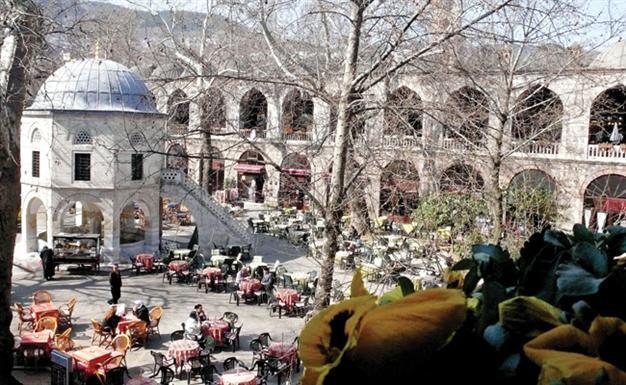Bursa’s Ottoman-era Koza Han maintaining 500-year-old draw
BURSA - Anatolia News Agency

Bursa’s historic two-story Koza Han is located in a wide rectangular yard with a water tank and a fountain under the small mosque in the center. It is one of the first stops for domestic and foreign tourists coming to visit its famous tea gardens and gift shops. The Han was even visited by Queen Elizabeth four years ago. AA photo
Koza Han, the last stop on the historic Silk Road in Anatolia, is one of the best-known examples of Ottoman heritage in the northwestern province of Bursa. Today, it is one of the first stops for domestic and foreign tourists coming to visit its famous tea gardens and gift shops. The historic place even hosted Great Britain’s Queen Elizabeth II in May 2008.The han, which is located between the Ulu Mosque and Orhan Mosque, was built in 1491 by the architect Abdul Ula Bin Pulad Shah as a foundation following an order from Sultan Bayezid II, according to the Bursa-Koza Han Silk Traders Association.
In past years, silkworm cocoons were sold at the han; silk fabrics obtained from those cocoons played a significant role in making Bursa a textile center.
Silkworm production
Turks living in and around Bursa and calling themselves “Manavs” have been producing silkworm for centuries, which is a tradition from Central Asia. This tradition still continues in the city but in recent years, silkworm production has decreased because of synthetic fabrics that are made from petrochemical products.
Koza Han, which was built with brick and cut stones, was restored in 1630, 1671 and 1784, while the small mosque in the center of the han was renovated in 1946 and 2007.
The facility has 95 rooms in total, 45 on the ground floor and 50 on the upper floor.
“The two-story Koza Han is located in a wide rectangular yard and has 95 rooms,” according to the website of the Bursa-Koza Han Silk Traders Association. “There is a water tank and a fountain under the small mosque in the center of the yard. Rooms have become shopping stores through time. There is also a section called ‘Outside Koza Han’ in the east of the venue. Those who came to the city in the past used to tie their horses up in this place. The Koza Han had different names in the past. These names were Cedid-i Evvel, Şimşek Hanı, Beylik Kervansarayı, Beylik Hanı, Cedid-i Amire and Yeni Kervansaray.”
Queen Elizabeth II visited the historic Koza Han in May 2008, when she was accompanied by President Abdullah Gül and his wife, Hayrünnisa Gül, along with then-Foreign Minister Ali Babacan and his wife, Zeynep Babacan.
After visiting the historic structure, the queen and her husband, Duke of Edinburgh Prince Philip bought silk fabrics from three stores. In one of the stores, the queen was given a silk headscarf with the signature motif of the Ottoman sultan as a gift.
















